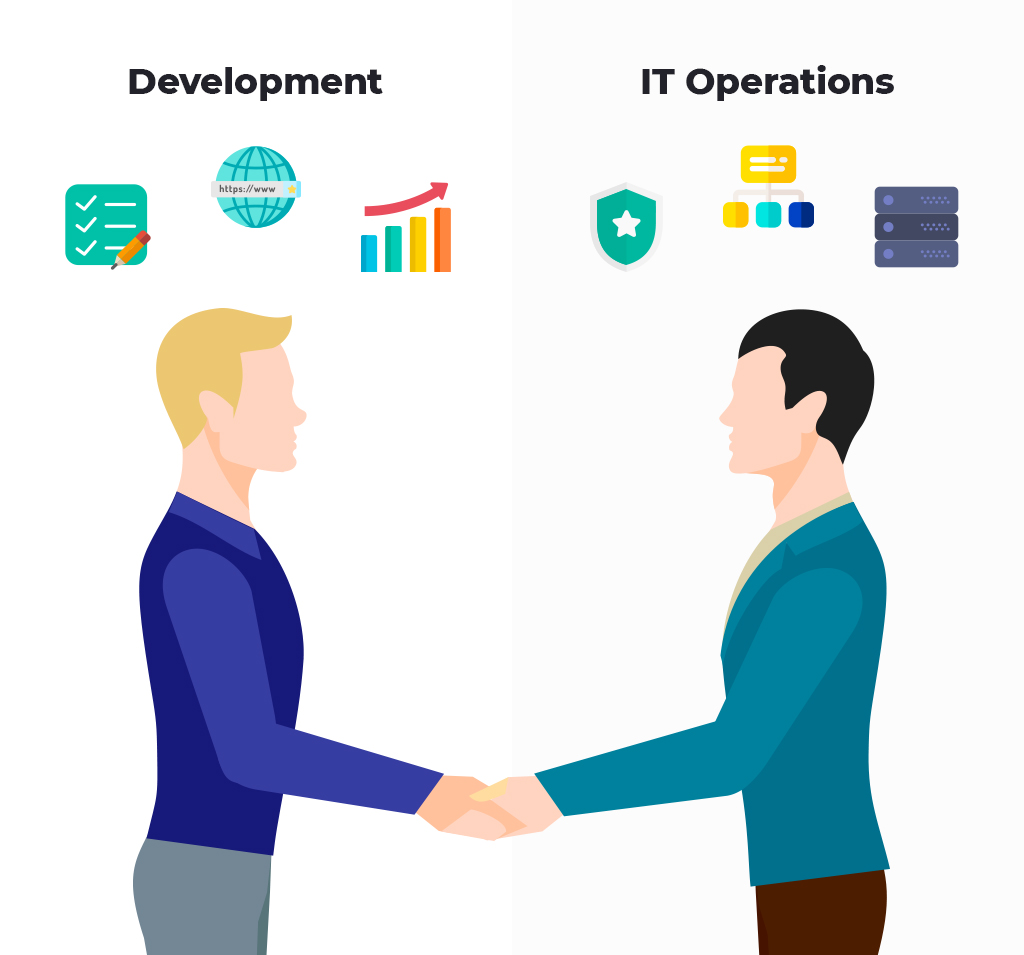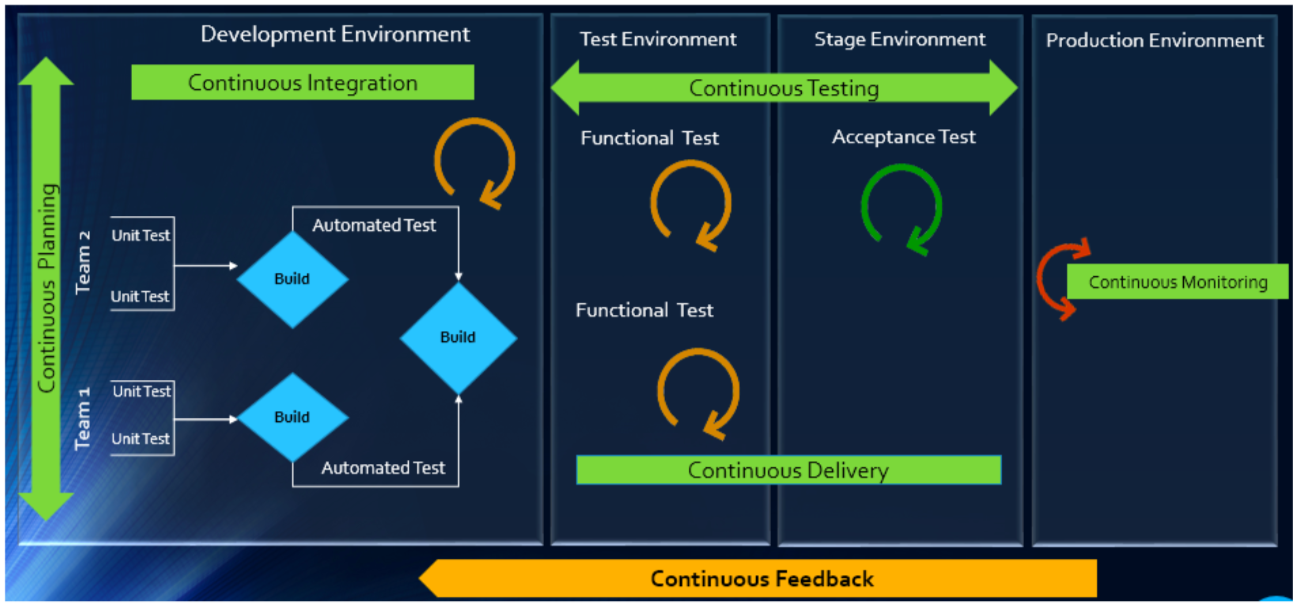The software technologies developed lately have solved many common problems of the people and have made their expectations raised to a par level. Customers are now adhering to quality, performance, services, and reliability of the software organization. Businesses are running head over heels to offer better solutions for new product additions, troubleshooting, client services and to match the current market trends.

DevOps being a buzzword has marked a significant place and has become a crucial segment in the world of software development. By integrating distinct tools and concrete practices that enhance the application delivery process, DevOps has led organizations to improve and meet targets at a faster pace, serving better and competing effectively in the prevailing market.
What is DevOps
Hewlett-Packard in its business white paper writes, ‘DevOps requires a cultural transformation. The approach encourages all parties to collaborate, communicate and share responsibilities, customer-orientated goals and business objectives.’

As the name advocates, DevOps is the unification of two distinct subdivisions, namely, Dev and Ops.
‘Dev’ usually refers to the software development encompassing a huge list of people engaged in the production of full-fledged working software. The team includes software developers, quality assurance engineers, product managers, to name a few.
On the other side of the coin lies, ‘Ops’ consists of people engaged in doing the IT infrastructure and operations part in the project. It consists of system administrators, system engineers, database administrators, network engineers, to name a few.
Why it Became Popular?
DevOps reached to the heights of the IT world matching the speed of a rocket. The biggest reason for this turnover was the existence of knowledge gaps between the software and hardware base gradually started depleting. To be very precise, in DevOps the development department and the operations engineers work side by side for the entire life cycle of the product development, starting from the design stage to development to implementation and support.

Before DevOps, the development and the operations teams used to work in complete isolation, no one knew what exactly was happening at the other end leading to a lack of collaboration, productivity, synchronization, an increase in cost, tough to track changes, etc.
Additionally, the migration to the cloud is another big reason by which DevOps reached new horizons in the software development methodology. Now, the operations team does not have to do infrastructure management, resulting in better performance and application delivery.
Why DevOps Automation is Crucial?
“If DevOps is the game of golf, then automation is like the putter. The game itself may be played for different reasons by different individuals—exercise, competition, just to get out and enjoy nature—but the fundamentals are the same no matter what the ultimate goal is,” says Tony Bradley, Editor-in-Chief of TechSpective.

The above figure shows a stereotypical CR (Change Request) handling process in an organization. Let's say, a ‘Change Request’ has been initiated by a customer through email or ticket submission with the helpdesk system. The updates regarding the issues were sent to the operations team, they, in turn, forwards the message to the concerned team of developers.
Once the development team completes the task based on the Change Request, the testing team takes over the command, the testing team deploys the solution and then connects with the developers for further feedbacks. And when the testing gets completed, the resultant solution gets deployed at the customer’s end.
This basic method of CR brings many drawbacks to it, such as manual interventions, communication delays, gaps in the processes, missing information in between. The discontinuation of information between development teams and customers will be destructive for the system as a whole.
Moreover, the involvement of several collaborators in the development loop, the most marched path has the chances of errors and miscommunications. After the development is done, the involvement of many internal and external contributors, at the time of the customer feedback part, adversely affects the thorough analysis response loop.
Role of Automation in DevOps
When projecting ahead with the software development procedure from the basic, the organizations performs the development process as per the specifications of the customers, which in turn leads the development team to work backwards by finding the needs of the customers, working on it and then delivering the products to the customers as per their customized requirements.
The distinct customer needs along with the current market trends, rigorous compliance requirements and set business aims open a lot many tabs for the development teams to manage and thus hampers the process of software development.
To address the issue, DevOps teams should adopt the systemized ways, workflows, technologies, protocols, etc. This will help in reducing the associated risks, enhancing the potential for automation. Standardization of DevOps is mandatory to build a better automation strategy for DevOps. Further, along with standardization, organizations should maintain a balance when it comes to the choice and use of tools for DevOps automation.
Automation in DevOps is not only bounded to the defining of the technology stack as executable but also as the capability of eliminating the performance bottlenecks, communication gaps and lack of process, information sharing between the team of developers, operations staff, etc. In addition to the former mentioned, the maintenance of continuity of the processes through the complete SDLC process.
The role of automation in DevOps extends to following notable tasks of the SDLC channel:
- Development of Code: Automation in source control keeps the game up for the developers, for example, when doing any changes in a build and stimulating appropriate changes or processes saves a lot of time. It is very much helpful in the simplification of large and complex software projects.
- Effective Tracing: Automation of the issue tracking and easy visibility of the cropped problem makes it more simplified for the operations team to do the follow-up for the same.
- Continuous Testing: Testing is supposed to be performed continuously during all the stages of SDLC in DevOps frameworks. It is the duty of developers and the QA to maintain requirements for a continuous testing environment ranging from automated communications trigger in between systems and team members, integration of multiple tests, prediction and tracking of the issues and facilitation of continuous integrations of the automated builds.
- CI/CD Enabling: Automation in Continuous Integration and Continuous Delivery confirms that the software builds, data, tests, and changes in the code get properly delivered to the target environments. With this, the DevOps teams will be able to handle the changes in the code, staging of the builds for testing and finally pushing the relevant software changes in the market.
- Incident Management and Monitoring: The reports, logs, and metrics received through incident reporting make it tough for the organization to keep a check on the infrastructure performance and potential issues. With the help of automation, event prioritization, identification of root causes and deliver proactive doable intelligence in the same.
Benefits of Automation in DevOps
1. Fast Turnaround
Liran Levy, R&D Life cycle DevOps Manager at Hewlett-Packard Enterprise states that DevOps process and automated testing has led them to deploy an HP Application Lifecycle Management release every three months which was earlier used to get deployed and released in 18 months. This has improved the rate of up to 83 percent straight.
Organizations with communication channels open all along with enhanced collaborations between the development and the operations teams lead to a paced up development environment, leading the organization to match the currently prevailing market trends and fulfill the customer needs to the earliest.
It has been said that automation reduces the time to market from weeks to days and to even hours. In addition to that, automation also does the reduction in the recovery time and helps in easy rollback and recovery from a failure.
The 2017 state of DevOps report by Puppet and DevOps Research and Assessment (DORA) states that teams practicing DevOps automation experiences 24 times faster recovery from failures and spend 22 percent less time spent on unplanned work and rework.
2. Better Business Focus
Small, big or medium, automation is imperative for every organization. Either the teams are counted in single digits or the teams are dispersed world-wide, automation will lead to effective and efficient use of resources keeping a perfect pace for the complete development structure.
With automation, the teams inside the organizations can focus more on the things that have a direct impact on the growth of their businesses, that is, things approaching improvements and innovations.
3. Reduction in the Release Cost
Replacement of manual process with automation leads to the removal of human error. This reduces the cost of repetitive upgradations, resulting in less cost.
Jonathan Fletcher, Chief Technology Officer at Hiscox, a specialist global insure, writes, We have had some great results from our DevOps initiatives so far. We reduced our cost per release on one application by 97 percent. These results largely arise from automation.
4. Reduced Risks
Due to the automation of DevOps less human-error and with efficient monitoring creation of real-time reports and dashboards for defects fixing and updates on the changes made leads on the spot addressing of the issue.
Best Practices
While flowing with the process of DevOps automation, organizations end up over-doing of the automation. This makes DevOps inefficient in production and can lead to undesirable outputs. The simple trick for the same is to keep up a balance between the over and under automation of the DevOps.
Being confirmed and precise for the development, testing and deployment requirements of the organization will lead to the selection of the right processes and tools. Proper training, if required, can be given to the development team and the administrators for the automation tools.
Recommended tools
- Docker: The lightweight VM, Docker, helps in the creation of the snapshot of the application that is reproducible, portable and reusable. Docker simplifies the configuration management, control issues and scales up to the process allowing containers to move from one place to another easily.
- Behat: As an open-source development framework in PHP, Behat offers automatic testing, deliberate discovery and continuous communication.
- Ansible: It automates many IT operations-related tasks, like, application deployment, configuration management, cloud provisioning. It integrates with many other open-source DevOps tools, JIRA, Jenkins, Git, to name a few. The free version is available in the Github while Red hat offers three paid versions - premium, standard, self-support - prices varying on the basis of support and number of nodes in production.
- Nagios: A validated infrastructure monitoring solution, Nagios is highly efficient in delivering results in distinct visual reports and representations.
- Git: The recent years have seen Git hosting innumerable open source projects, managing the source code and has become immensely popular among developers with features like pull request and forking. Moreover, the plugins that can link with Jenkins facilitating deployment and integration.
Final Note
DevOps has gained a top-notch place in the minds of the developers. DevOps brings more integrity by offering an effective collaboration between the development and operations teams. With the automation of DevOps high level of productivity can be attained. However, achieving automation is not that easy as it seems. Integration with many known tools from different domains will bring efficient solutions for DevOps' automation. When done insightfully, automation of DevOps will help organizations to escalate towards the high-limit of productivity.
Subscribe
Related Blogs
Trek n Tech Annual Retreat 2025: A 7-Day Workcation of OSL

OSL family came together for the Trek n Tech Annual Retreat 2025, a 7-day workcation set amidst the serene beauty of…
Exploring Drupal's Single Directory Components: A Game-Changer for Developers

Web development thrives on efficiency and organisation, and Drupal, our favourite CMS, is here to amp that up with its…
7 Quick Steps to Create API Documentation Using Postman

If you work with API , you are likely already familiar with Postman, the beloved REST Client trusted by countless…




